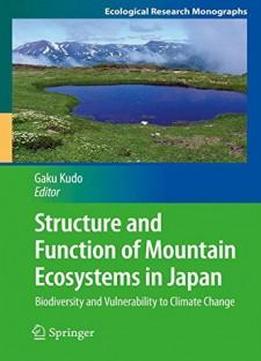
Structure And Function Of Mountain Ecosystems In Japan: Biodiversity And Vulnerability To Climate Change (ecological Research Monographs)
by Gaku Kudo /
2016 / English / PDF
5.2 MB Download
The purpose of this book is to summarize new insights on the
structure and function of mountain ecosystems and to present
evidence and perspectives on the impact of climate change on
biodiversity. This volume describes overall features of
high-mountain ecosystems in Japan, which are characterized by
clear seasonality and snow-thawing dynamics. Individual chapters
cover a variety of unique topics, namely, vegetation dynamics
along elevations, the physiological function of alpine plants,
the structure of flowering phenology, plant–pollinator
interactions, the geographical pattern of coniferous forests,
terrestrial–aquatic linkage in carbon dynamics, and the community
structure of bacteria in mountain lake systems.
The purpose of this book is to summarize new insights on the
structure and function of mountain ecosystems and to present
evidence and perspectives on the impact of climate change on
biodiversity. This volume describes overall features of
high-mountain ecosystems in Japan, which are characterized by
clear seasonality and snow-thawing dynamics. Individual chapters
cover a variety of unique topics, namely, vegetation dynamics
along elevations, the physiological function of alpine plants,
the structure of flowering phenology, plant–pollinator
interactions, the geographical pattern of coniferous forests,
terrestrial–aquatic linkage in carbon dynamics, and the community
structure of bacteria in mountain lake systems.
High-mountain ecosystems are characterized by unique flora and
fauna, including many endemic and rare species. On the other
hand, the systems are extremely vulnerable to environmental
change. The biodiversity is maintained by the existence of
spatiotemporally heterogeneous habitats along environmental
gradients, such as elevation and snowmelt time. Understanding the
structure and function of mountain ecosystems is crucial for the
conservation of mountain biodiversity and the prediction of the
climate change impacts.
High-mountain ecosystems are characterized by unique flora and
fauna, including many endemic and rare species. On the other
hand, the systems are extremely vulnerable to environmental
change. The biodiversity is maintained by the existence of
spatiotemporally heterogeneous habitats along environmental
gradients, such as elevation and snowmelt time. Understanding the
structure and function of mountain ecosystems is crucial for the
conservation of mountain biodiversity and the prediction of the
climate change impacts.
The diverse studies and integrated synthesis presented in this
book provide readers with a holistic view of mountain ecosystems.
It is a recommended read for anyone interested in mountain
ecosystems and alpine plants, including undergraduate and
graduate students studying ecology, field workers involved in
conservational activity in mountains, policymakers planning
ecosystem management of protected areas, and researchers of
general ecology. In particular, this book will be of interest to
ecologists of countries who are not familiar with Japanese
mountain ecosystems, which are characterized by humid summers,
cold winters, and the snowiest climate in the world.
The diverse studies and integrated synthesis presented in this
book provide readers with a holistic view of mountain ecosystems.
It is a recommended read for anyone interested in mountain
ecosystems and alpine plants, including undergraduate and
graduate students studying ecology, field workers involved in
conservational activity in mountains, policymakers planning
ecosystem management of protected areas, and researchers of
general ecology. In particular, this book will be of interest to
ecologists of countries who are not familiar with Japanese
mountain ecosystems, which are characterized by humid summers,
cold winters, and the snowiest climate in the world.











